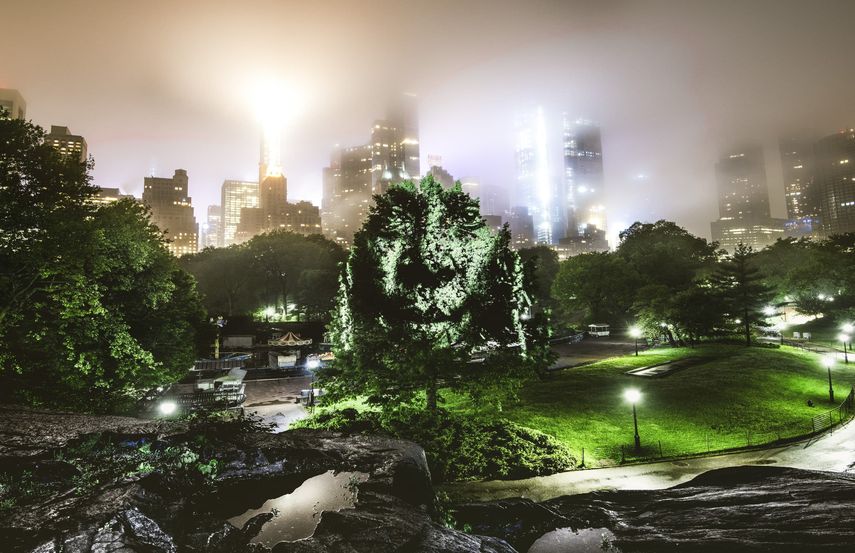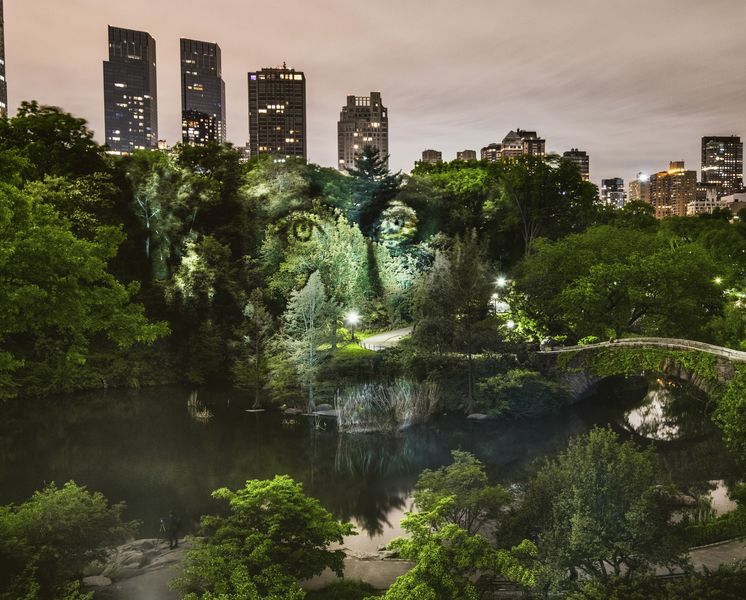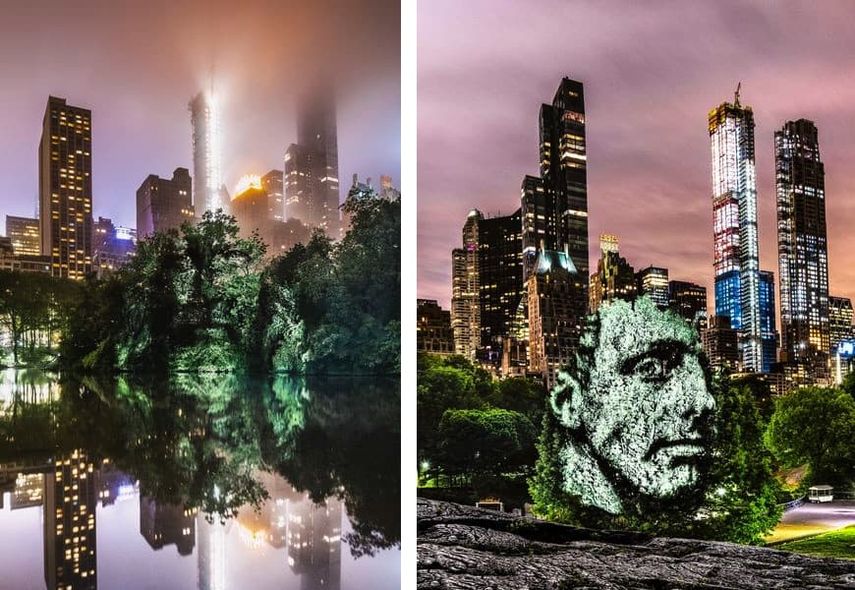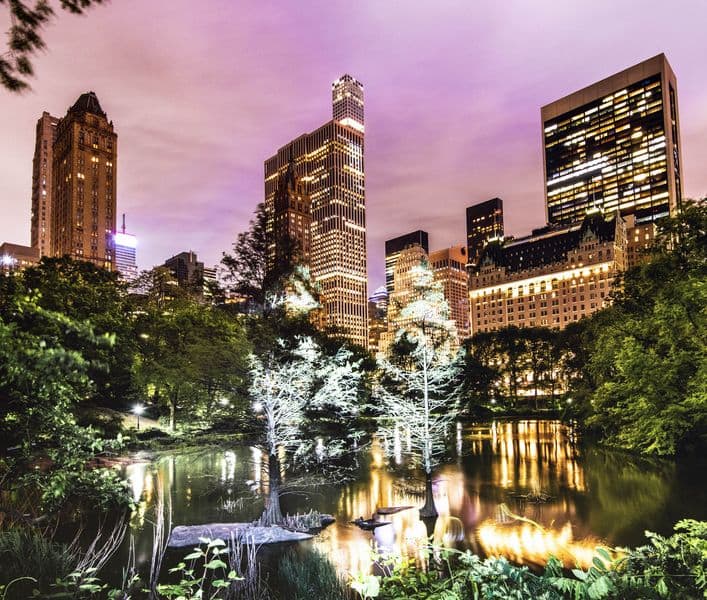[ad_1]
A French portrait photographer, Philippe Echaroux has a unique approach to the photographic image. Using light as his medium, he creates personal projects with strong meanings.
As the artist explains, he started photography “somewhat by chance” when he bought a Fuji 6500FD bridge camera out of pure curiosity in 2008. Spending some time experimenting with the light and the medium in general, this purchase triggered the rest of his career.
With the 2016 project in the Amazonian forest, where he photographed the faces of people from the Suruí tribe and projected the images onto trees in the virgin forest, Philippe presented his own vision of street art, describing it as Street Art 2.0.
I wanted to create my own way of doing street art. There are already extraordinary artists using spray cans or collages, so my starting point was the tool I master best as a photographer: light.
Echaroux creates ephemeral light installations all around the world, illuminating the surroundings with the projection of compelling portraits he creates. Whether placed on a building, a tree, a bridge, a façade or the site of a dramatic event, his art conveys powerful messages about environmental issues challenging our times.
We had a chat with Philippe Echaroux to find out more about his compelling practice. In an exclusive Widewalls interview, he talks about using light, the project in the Amazonian forest, his latest installation in New York, the power of art to fight social battles, and much more.

The Light as a Medium
Widewalls: You have invented a unique way of exercising street art called Street Art 2.0, a sort of light graffiti. How did you first decide to use light as a medium in such an innovative way?
Philippe Echaroux: I was a social worker at first. I started a career in the photography world as a portrait photographer. I quickly understood that what was interesting to me in photography was the light management and that became my signature.
Once my portrait photographer career launched, I felt that I was missing something. I started having interest in the street art movement, mainly because of the social power of this art [form] and its accessibility to everyone.
I wanted to create my own way of doing Street Art. I decided to use the tool I knew best – the light.
Another advantage of light is that the ephemeral appearance we make leaves no mark on the environment. I really wanted to create something with the utmost respect for the place I place my art.
This was the moment when all this adventure was born.
Widewalls: Among your first installations of this kind was the one in the Amazon rainforest that brought forth the threats facing local indigenous people and their surroundings. Could you tell us more about this? What was your experience of working with Surui tribe like?
PE: Just incredible. The Amazonian adventure is a two year’s work for a 7-day installation, but these 7 days were the best of my life. I was so glad to be able to bring something to this tribe, I didn’t want to be the random guy coming to the tribe and having all the credit for the project.
I love extreme sports, those which take place in nature. I have always been connected to this world and to nature. It was so natural to start making art in nature after having used the great laboratory of the city.
The goal of the Amazonian project was to show that when you put down a tree it’s like putting down a man. That’s why we projected the face of the Surui tribe on the trees, to personalize them.
When you see the connection that these people have with the forest… the pictures I brought back are faaaaaar less powerful than this!

Raising Awareness About Environmental Issues
Widewalls: Your most recent project took place in Central Park in New York. Could you tell us something about the artistic vision behind this project? What is it about this time?
PE: Sure, there were two main goals.
The first was to show the contrast after the Amazonian project. In NY, it’s not nature which surrounds the people – it’s the people who try to surround nature. In NY, nature is well defined within a rectangle, so I thought that was a good place to enlight this reflection.
Who surrounds who? You already have the answer, but sometimes there is an illusion it is we who dominate nature.
The second reason was a more basic one. I love a challenge and I love to do things that haven’t been done before. Making the World First in NY was a challenge I wanted to face!
Widewalls: In 2017, you launched the “After the Dream” initiative that aims to raise awareness of the young generations about an environmental cause – the problem of littering. What was the reach of this project and the response you have received from the public?
PE: The goal was to sensibilize the children. We tried to create a project where children can be actors. I am so glad because today, there is more than 50,000 pieces of trash that have been picked up.
It was very hard to make this project visible in schools, but now people are speaking about it and our mailbox (contact [at] afterthedream.com) is full of new pieces of art made with trash! It’s a great step forward!
Widewalls: Your portraits mostly depict random people that you meet in the street. Could you tell us something about these encounters?
PE: On that side, everything is done randomly. We go to a place for a project and since I am never the best person to speak of a place where I don’t live, I try to meet local people. Making portraits is a good way of doing it. But you have to know that in addition to the picture we make, we, of course, explain the project and then people always give their opinion and ideas.
This is precious because it helps me combine my ideas and the feedback and sentiment of the local people, which is always better than me speaking about a subject someone else knows better.
The shooting of people portraits is a very important part of each project. You have a portrait to project and you place the focus of your project on the good goals!

Art and the Social Battles
Widewalls: You place a great focus on environmental issues affecting our planet. How do you think art can contribute to fighting social and political battles of today?
PE: To be honest, I don’t think it can do it directly, but it can help initiate a movement or help the issue become visible. We have to be realists, it’s not artists who take the BIGGEST decision, but they can be actors in it in an indirect way.
In my opinion, my role is to ask the question that starts the dialogue. That is where the artist has to be. If the artist is the one to give an answer, then he is just another stupid guru knowing the only mighty truth.
Art is a great way to help people think and make them react and discuss – just choose the subjects wisely.
Widewalls: What is the responsibility of art taking place in the public space? Can public art afford to be apolitical?
EP: I don’t think my art is political and I hate when people speak about politics because everybody seems to know THE truth. This might be the main problem?
Writing things in the street might always be political, but I let people make politics with the reflections I put in the streets.
My goal is to make people think about themselves with these reflections (remember, I was once a social worker!) or to think about something I want to highlight.
The only responsibility of an artist, in my opinion, is to try to create art with meaning. Not for money, not for beauty, but to be useful to the society. A lot of artists feel like they are useless or against the society but they are actually being a part of it and every society needs this!
Widewalls: The majority of your work is ephemeral. How does this temporality fit into your practice?
PE: We are ephemeral too, aren’t we? Working with ephemeral art is just a good way to always have this in mind.
Widewalls: Could you tell us something about your future plans and projects?
PE: You’ll see it soon… ?



Featured image: Portrait of Philippe Echaroux in New York. All images courtesy the artist.
[ad_2]
Source link
